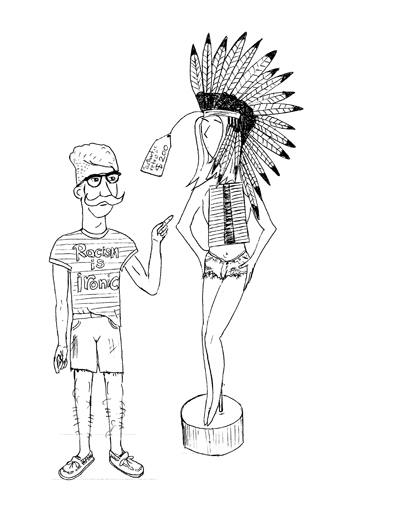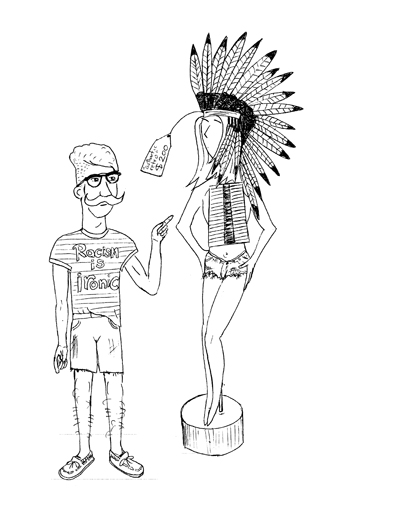
There’s been much to be angry about during this year’s Native American Heritage Month.
Victoria’s Secret got into trouble after consumers expressed anger toward the faux-Native American outfit one of their models wore while strutting down the runway. Apparently, the company did not realize that dressing Karlie Kloss in a floor-length headdress, turquoise-stuffed bikini and high-heeled moccasins would rustle some people’s feathers the wrong way.
Gwen Stefani’s No Doubt pulled a music video off of the Internet after consumers responded in anger at its visual content. The video for their mediocre and arbitrary song, “Looking Hot,” involved full-out, stereotypical Native American costumes, cowboys, teepees and in one scene Gwen Stefani (or white pocahontas, I’m not sure) is bound in ropes at gunpoint.
Added to other singers and entertainers who use Native-esque garb to sell their “art” (Lana Del Ray, Ke$ha) such controversies this month reveal that consumers are getting fed up with cultural appropriation and are sending a message to the culture industry – don’t appropriate, just appreciate.
In No Doubt and Victoria’s Secret’s defense, they probably did not know how offensive they were being. But that’s exactly the problem.
The culture industry has always used ethnic or indigenous symbolism in irresponsible and ignorant ways, and No Doubt and Victoria’s Secret are certainly not the first to use stereotypical depictions of Native Americans or Native American iconography to commercialize their products – although this is definitely not the first time Gwen Stefani has appropriated cultures to make herself more interesting (i.e. harajuku girls, Indian bindi, chola makeup and outfits). The Washington Redskins and the Cleveland Indians have been using Native American imagery to promote their teams for years.
What’s the difference between cultural appropriation and cultural appreciation? The latter is having genuine interest in learning about a people’s history, traditions, language, values and way of life. Appropriation is based on a superficial appreciation of a group and uses convenient parts of that group’s culture for commercial reasons. It is damaging because doing so ignores the experiences of minorities and marginalized people.
“The No Doubt music video re-enacted images of conquest and colonization, taken not from history, personal knowledge, or authentic experience, but from Hollywood,” said Professor Scott Andrews, coordinator for the American Indian studies program at CSUN. “They are turning a complicated and often painful history into a campy farce.”
The painful history of Native Americans includes over 500 years of being colonized, slaughtered and marginalized. However, this history is often mistaught or misrepresented, making cultural appropriation all the easier to commit, especially around the Thanksgiving holiday.
In the Los Angeles public school system, I remember being taught in elementary school that Thanksgiving is celebrated to remember when the pilgrims and “Indians” came together to eat squash and turkey. The Indians heroically saved the pilgrims – colonizers – from starvation and they lived happily ever after in America. Oh and also Pocahontas married John Smith.
According to Professor Theresa Montano, a former public school teacher, romanticizing the first thanksgiving story perpetuates ignorance of what resulted from that encounter. For many indigenous Americans, thanksgiving is a day of mourning.
“The connotation of what we attach to that day is that we are thankful to them (the Native Americans) for providing the meal,” said Montano. “We don’t talk about what happens after, the historical oppression, disease, robbing of the land. We don’t teach that to our children and we send the message that we were rightful to take that land.”
This attitude is perpetuated in middle school and high school education despite inclusion of historical events such as the Trail of Tears and the removal of native people during American expansion.
According to Montano, most history lessons do not include the struggle that Native Americans put up to resist colonization. This perpetuates the idea that the natives mostly died because of their inability to survive European diseases and because their inferior weapons could not defend them against more advanced colonists. We are taught that events such as the Trail of Tears were necessary sacrifices for expansion.
The ignorance or romanticism of native history coupled with the exclusion of native people as producers within the culture industry has allowed for appropriation to be acceptable and fashionable.
“Hipsters turn appropriated culture into a commodity,” said Andrews. “Seeing a cultural identity as something to be purchased rather than lived, and abandon it when it becomes inconvenient or unfashionable without any consequences.”
The real damage is caused not just by one event, but the cumulative effect of appropriation throughout the centuries. Fortunately, the Internet allows for Native Americans and other marginalized groups, as well as those who simply do not appreciate appropriation, to have a greater voice in what gets mass produced. Hopefully, the culture industry will understand that you can’t talk about people as if they do not exist, and be more careful with what they try to sell.
I’m talking about you, Gwen Stefani.






